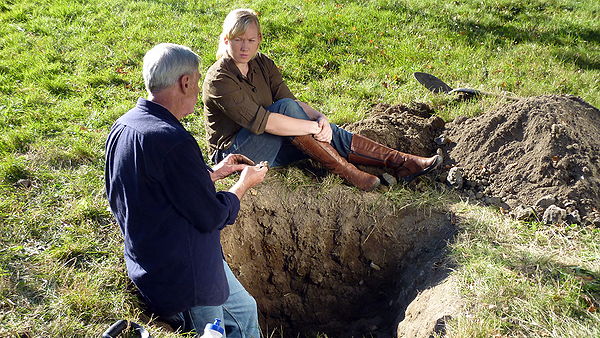LFS:SoilWeb/Soil Classification/Canadian System of Soil Classification
Classification involves arranging individual units with similar characteristics into groups. Soils do not occur as discrete entities and soil “individuals” (or pedons) are not obvious. A pedon is defined as a 3-dimensional body, commonly with lateral dimensions of 1 m and depth of 1 to 2 m. A vertical section of a pedon displays the more-or-less horizontal layers (or horizons) developed by the action of soil-forming processes.

Soil classification improves communication and inferences about soils’ responses to management practices (Photo: Dr. M. Krzic, UBC).
Soil classification facilitates the organization and communication of information about soils, as well as the understanding of relationships between soils and environmental factors. The Canadian system of soil classification is designed to cover only Canadian soils. The land area of Canada (excluding inland waters) is approximately 9,180,000 km2, of which about 15% is rock land, and the remainder is classified according to the Canadian system of soil classification.
There are five classes (taxa) recognized in the hierarchical scheme used for the Canadian system of soil classification. A summary of the principles used for differentiating between taxa, from the highest to the lowest level of generalization, is presented below.
| Taxa | Principles Used | No. of Classes |
|---|---|---|
| Order | Dominant soil-forming process | 10 |
| Great Group | Strength of soil-forming process | 31 |
| Sub Group | Kind and arrangement of horizons | 231 |
| Family | Parent material characteristics | About 10,000 |
| Series | Detailed features of the pedon | About 100,000 |
The classification system makes it possible to consider soils at different levels of specificity. Soil classes are defined as specifically as possible to permit uniformity of classification. Limits between classes are arbitrary as there are few sharp divisions of the soil continuum in nature. Differences in soils are the result of the interaction of many factors: climate, organisms, parent material, relief and time. The soil classification system changes as knowledge grows through soil mapping and research in Canada and elsewhere.
Soil Orders
The table below provides a summary of 10 soil orders in the Canadian system of soil classification:
| Order | Diagnostic Horizon | Comments |
|---|---|---|
| Chernozemic | Ah, Ahe | A grassland soil whose diagnostic horizon is formed by high levels of organic matter additions from the roots of grasses. |
| Solonetzic | Bn or Bnt | A grassland soil with high sodium levels in the B horizon; usually associated with a clay-rich B horizon and often with saline C horizon material. |
| Podzolic | Bf or Bh | A forest soil normally associated with coniferous vegetation on igneous-rock derived parent materials. High acidity in the A horizon results in formation of a bleached Ae horizon and deposition of iron and aluminum in the B horizon. |
| Luvisolic | Bt | A forest soil found in areas with parent materials derived from sedimentary rocks. Dominant process is eluviation of clay from the Ae horizon and its deposition in the Bt horizon. |
| Brunisolic | Bm | A forest soil whose properties are not strongly enough developed to meet the criteria for the Luvisolic or Podzolic Orders. |
| Gleysolic | Bg, Cg | Found throughout Canada wherever temporary or permanent water saturation cause formation of gleyed features in the profile. |
| Regosolic | No B horizon | Found throughout Canada wherever pedogenic conditions prevent the formation of B horizons (unstable slopes, sand dunes, floodplains etc.). |
| Vertisolic | Bss, or Css and Bv | Associated with high clay glacio-lacustrine landscapes; characterized by shrinking and swelling of clays. |
| Cryosolic | By, Cy, Cz | A soil of arctic and tundra regions; characterized by presence of permafrost. |
| Organic | O horizon | Organic soils are associated with the accumulation of organic materials (peat) in water-saturated conditions. They are most commonly associated with Boreal Forest soils. |
| RELATED LINK:
Soil Orders of Canada: The University of British Columbia and Agriculture and Agri-Food Canada. The objective of this teaching tool is to provide video footage of soil identification and classification. The teaching tool consists of 10 videos that illustrate characteristics of 10 soil orders within the Canadian System of Soil Classification. Numerous soil description and identification techniques are demonstrated. This material provides a valuable teaching resource for various courses in soil science, agriculture, forestry, and natural resource management either as an in-class or off-campus review. |